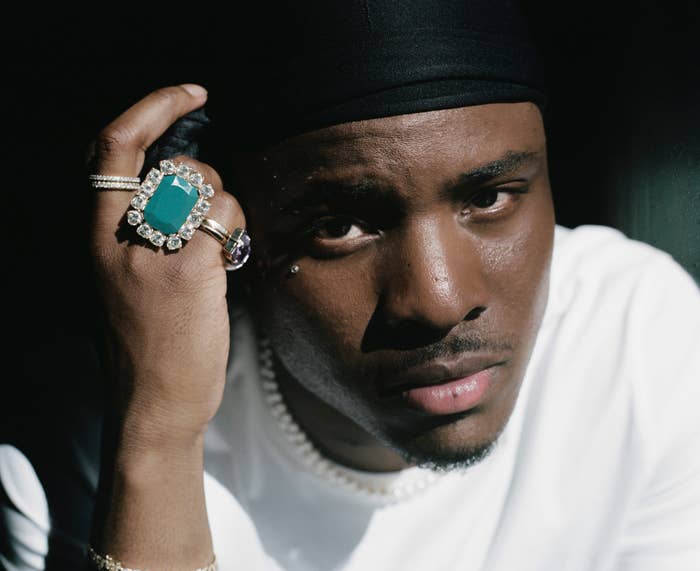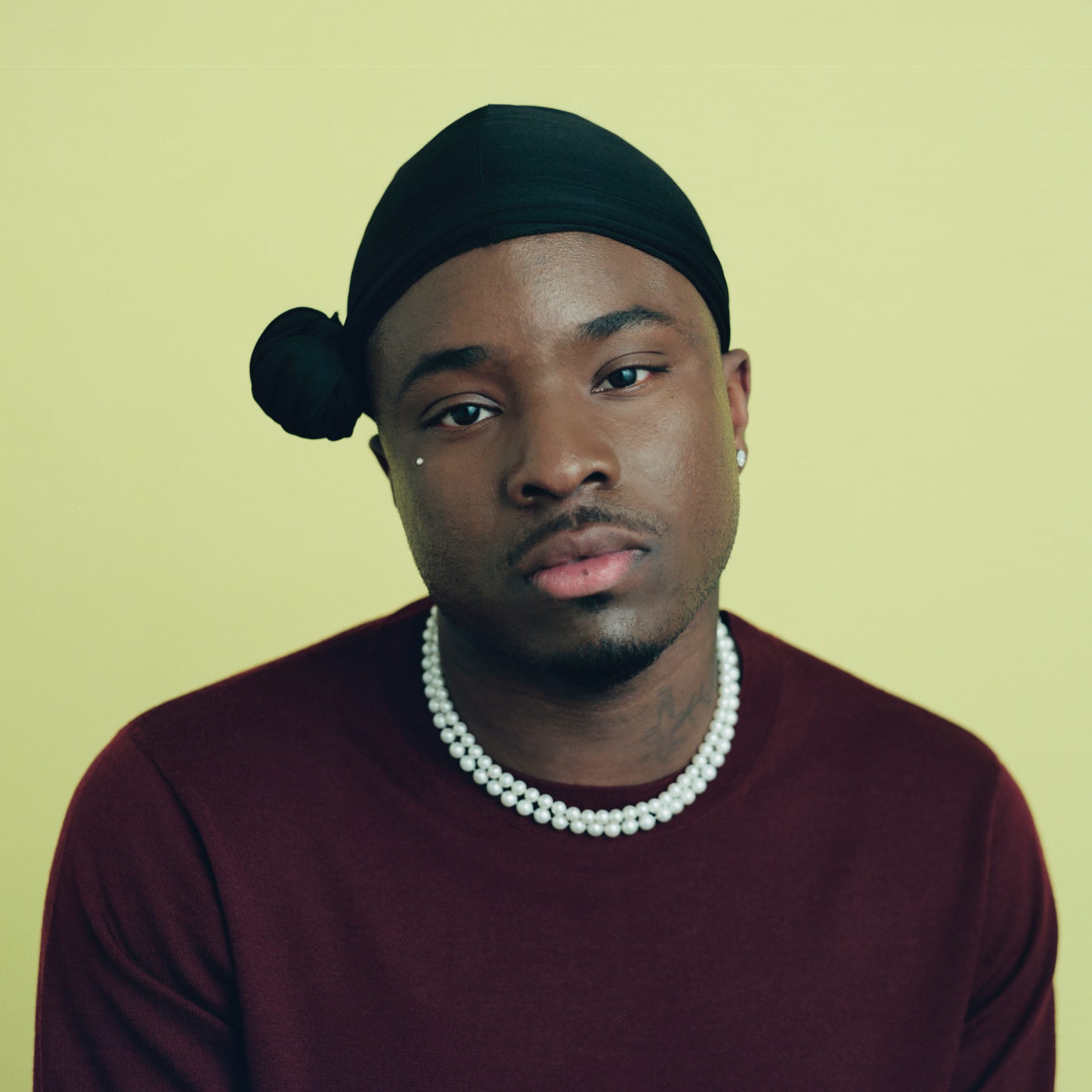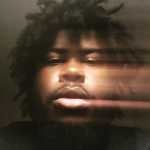
IDK has always been lauded by his fans for the deliberate vision and effort he puts into his music. He’s an ambitious artist who seeks to tell overarching stories in his projects, linking each song to an overall theme. One would have to be a creative tactician to fully explore the layout of projects like 2015’s SubTrap and 2019’s IWASVERYBAD.
But his ardent fans might not know the foresight behind his latest work USEE4YOURSELF, a project he’s known he needed to make for the “past three or four” years.
Deeply confessional songs like “Cry In Church” and “Hey Auntie” show why the 29-year-old PG County artist says the project helped him “become a better person.” The second half of the album, in particular, features him delving into childhood trauma and the ways that seeing dysfunctional relationships as a kid informed his lack of vulnerability with women later.
The project is cathartic—not just for IDK, but for the hoards of people who’ve listened to the project and found solace in his recounting of feeling unloved, and even facing sexual violence on “Hey Auntie.”
Beyond the introspective nature of USEE4YOURSELF, IDK has positioned himself as not just a thoughtful rapper, but one of the game’s more enterprising curators. The mostly self-produced project is a mesh of synths and rhythmic percussion, with beats switching and morphing in lockstep with each song’s lyrical shift. He invites a slew of guests onto the project, from MF DOOM, Westside Gunn, and Jay Electronica on “Red” to Offset on “Shoot My Shot” to Slick Rick on “Hey Auntie.” There’s also a DMX prayer on “Cry In Church” that IDK had to personally ensure was going to be cleared by the recently-passed legend.
Tracks like “PradadaBang” with Young Thug, “Shoot My Shot” with Offset, and “Keto” with Swae Lee and Rico Nasty are tailor made for the function. “Puerto Rico” with Lucky Daye is a sultry ode to a woman who’s caught his eye.
But of course, even within the feel-good singles lie glimpses of toxic behavior that convey the project’s overall statement about how the lack of love we get can manifest into a lack of genuine love in relationships down the road. I spoke with him while he was on the way home from the Benz dealership about a range of topics including the project, his “No Label Academy” at Harvard, and what he thinks Black men can do to unlearn toxic traits. The interview, lightly edited for clarity, is below.
Your new album, USEE4YOURSELF, has been out for about a week now. How are you feeling about the reception?
I’m feeling great, man. People seem to love it, people seem to get it, and that’s important. People are supporting it, so all of the most important things are happening, and I’m feeling good about that.
What are people saying that lets you know they get it?
People are crying, people are saying that they are going to see a therapist now that they’ve heard this album. People are saying that they feel more comfortable talking about certain things that have happened to them in their lives. For me, those are the things that matter the most.
You tweeted that you needed to make the project to “become a better person.” Can you expand on the cathartic value of creating the project?
I think expressing myself helped me because it took away a sense of fear—a fear of people finding out who I am. The fear that a lot of us have that causes us to not say the things that we have bottled up inside. The fear that makes us need a therapist, because those are the only people we feel like we can trust. Vulnerability, and being able to express the truth when it comes to that, is literally a superpower. You learn that, and life will be so much easier. It’s so simple, but we make it so hard.
What was it like recording some of the most personal moments on the album, like “Hey Auntie” and “Cry in Church?” What was that writing process like?
The writing process was me freestyling what was in my mind, barely any writing—just getting on the mic and saying what came to my mind and what I felt, to be honest.
And the beat just compelled certain themes and ideas out of you?
Yes, the beat dictates what I want to do and where I go with things. For sure.
There is a lot of movement on the album. Can you speak to your creative vision in terms of wanting to make the album sound more layered and cinematic at certain points?
I always layer the skeleton of what I want to do down, and try to make sure it’s as on-point as possible. I tend to write my own strings, or me and [Blue] Rondo and Eden [Nagar] will sit down and write the strings. I’ll write the melody and they’ll actually put it to sheet paper for people to play. So me and them usually do things like that. Arrangements usually follow lyrics, but sometimes it all happens simultaneously. There’s no one way.

You have several moments with legends on the project. How did “Red” come together with MF DOOM, Jay Electronica, and Westside Gunn?
For that one, I heard the beat and I knew I wanted Westside Gunn on it. The DOOM thing was part of a longer verse that I just decided to cut down for time sake. And I just liked that little snippet of having him in there to get people hyped up and then lay the bed of what we were going to do, so he did a pre-hook. And it took Jay Electronica a while to send me that verse back. There was a lot of waiting, but he sent me an “Ether” verse back, and that was the final touch.
With the DOOM verse, was that originally for “Red,” or was it for another song?
It was for something else around the same BPM.
Do you feel like you might explore the rest of the verse on a future project?
Could be. It’s a matter of his estate and where they’re at with it. I can’t speak to that, but I’m just glad that they were able to let us do what we were able to do with what we have.
You have a music business course at Harvard coming up in August for students of color. How did that come together?
It came together from just an idea I had for a while. It pretty much came to life when I got to go on campus and work with the No Label crew, Miles [Weddle] and Marcelo [Hanta-Davis]. They brought the logistics to the idea, and I found a way that we could work together to create this program.
I read an article about the program, and you noted that you wanted the BIPOC community to know that a job in the arts is a lot more realistic than what society makes it seem. Can you expand on that, especially in the context of letting people know that there are more pathways into the music industry beyond being a rapper or producer?
Some people might want to be a publicist; some people want to be a manager. This isn’t about teaching you how to record beats on Pro Tools or make beats on Logic. This is about teaching how to understand the business and what it takes to be able to monetize and make money. And with that, creating a sustainable career.
You’re having the initial course in August. Are the hopes that this could become annual or a more periodic thing?
For sure. That’s exactly the goal. We just want to show proof of concept that this is important and can be well done, and from there, we’ll do the rest.
You recently redesigned a basketball court at the Oakwood Rec Center in Maryland. How important is it for you to put on for your home and community?
The most important thing for me is I’m an example of success for a lot of people. Even when I feel like I have more work to do, there’s a lot of people who would die to be in the position that I’m in. So, my idea is showing them that I’m here, I’m close, and I’m within reach. And then using my platform to create an environment for them to be able to dream and think about things that they want to become, and to not feel like it’s not possible.
I saw several partnerships you announced with Nike, Guess, and other brands in the pipeline. How does it feel to work with these major brands? And what do you hope to bring to the partnerships?
I think it’s great to have iconic brands that believe in what my vision is enough to give me creative control to create the story. I think that’s amazing, and I think what I bring to the table is a perspective that’s much-needed. But not just a perspective, also the articulation of the perspective, because a lot of people aren’t very good at articulating to corporate brands, and that’s one of the things I’m starting to specialize in.
How did Slick Rick’s appearance on “Hey Auntie” come about?
When I heard the song, I knew I wanted him on it. I just reached out to him via DM and he responded and was like, “Yeah, I’m down to try something.” And he sent it and killed it. It was just straight through DM, and then it turned into FaceTime, then we got the song done.
There’s also DMX’s prayer on “Cry in Church.” How did that come together?
That was just basically a sample from a previous prayer, and he cleared it before his passing.
Did you get to have any interaction with him?
Yeah, I had to chase him for the last time. I had to pull up on him at SXSW, like, “Yo, man we have to get this cleared.”
The Neptunes produced on “Keto.” How did that come together?
I just happened to be in Miami and was like, “Yo, I want to get in with Pharrell.” I told my publisher, and then a couple of hours later they were like, “Yup, Pharrell is good to do the session tomorrow.” I’ve always wanted to do that. I actually have said that I didn’t want to drop this album until I got a session with Pharrell, so it was cool.
At what point in the process did you get that goal accomplished?
It was in the earlier stages.
You made a post on Instagram explaining a bit about what the album was about, and you referenced the misuse of love within your relationships and how toxic masculinity spurs toxic relationships. That’s evident on the project from a male perspective, but there are moments on the project that are critical of women in relationships. What do you hope women take away from the project?
I want women to be able to see the transparency of a man who they may want to love, but don’t feel like they’re getting that love the same way that they’re able to give it. And understanding that we need patience and help to get to that point to be able to give it to them the way they need it and deserve it. Some of us, not all of us.
What do you think is the practical path for men to unlearn harmful relationship traits in a toxic world?
I think men can navigate that by having other men—and even women—create an environment where it’s OK. And not just OK, but praised. I know a lot of women say that they find it very attractive for a man to be in touch with his feelings and be vulnerable because they don’t get it enough. I think expressing that more will make men feel more comfortable. A lot of men, obviously depending on your sexuality, are chasing women at the end of the day. A lot of the things we do is for them. So them making it very apparent that that’s what they like, I’m sure we’ll trigger a lot of men to be more that way.
In the conception of the album, what are some of the books or movies that inspired you to have these revelations that you express on the project about relationships and toxic masculinity?
Nothing but self-reflection and being able to solve problems. I look at myself as a problem solver, and when I see a problem, I figure out ways to solve them. That’s really what it’s about more than anything.
How did you know that these were the topics that you wanted to tackle on this album?
I always knew. I always knew that I had to face my fears and problems. That’s what music has always been: an outlet for me. So I always knew that. I think it’s been about three or four years of making music that told me I have to do this eventually.



